Higher classification Gray wolf | Rank Subspecies | |
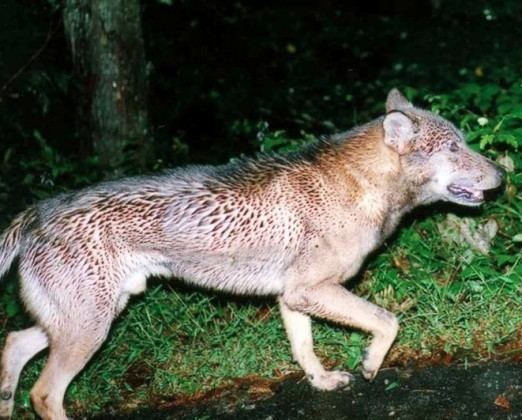 | ||
Similar Gray wolf, Hokkaido wolf, Japanese river otter, Canis, Canidae | ||
Lost animals japanese wolf
The Japanese wolf (Japanese: ニホンオオカミ(日本狼 ー, Hepburn: Nihon ōkami) (Canis lupus hodophilax) is an extinct subspecies of the gray wolf that was once endemic to the islands of Honshū, Shikoku, and Kyūshū in the Japanese archipelago. It is also known as the Honshū wolf. Its binomial name derives from the Greek Hodo (path) and phylax (guardian), in reference to Japanese folklore, which portrayed wolves as the protectors of travellers. It was one of two subspecies that were once found in the Japanese archipelago, the other being the Hokkaidō wolf.
Contents
- Lost animals japanese wolf
- Japanese wolf or wild dog
- Etymology
- Nomenclature kami and yamainu
- Skeletal and genetic findings
- Range
- Physical characteristics
- History
- Culture
- References
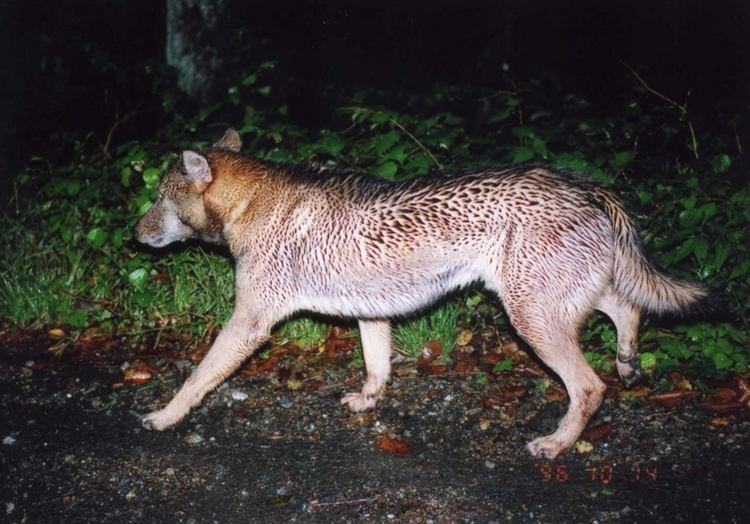
Japanese wolf or wild dog
Etymology
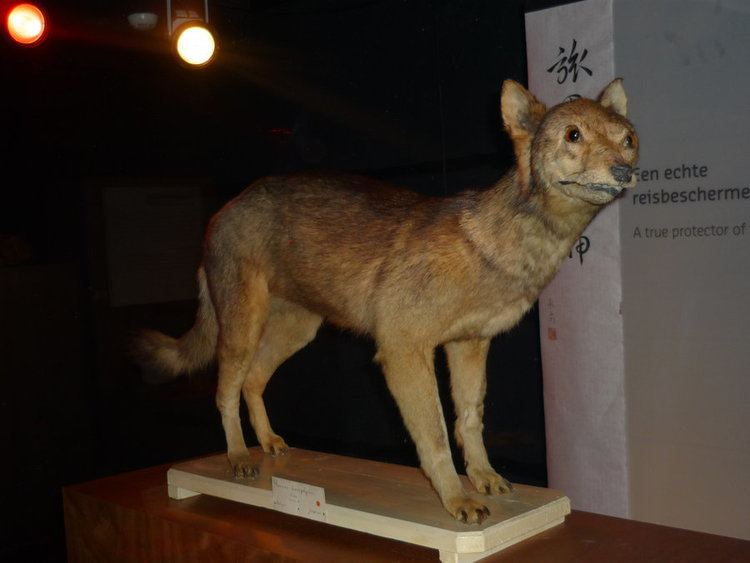
The name ōkami (wolf) is derived from the Old Japanese opo-kami, meaning "great-spirit". In the Shinto religion, wild animals were associated with the mountain spirit Yama-no-kami.
Nomenclature: "ōkami" and "yamainu"
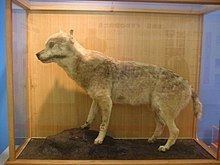
Before Temminck classified it, it had been long recognized in Japan that Honshu was inhabited by two distinct canids; ōkami (wolf) and yamainu (mountain dog), both of which were described by the herbalist Ono Ranzan in his Honzō kōmoku keimō (“An instructional outline of natural studies”) in 1803. He described the ōkami as an edible, but rapacious, greyish-brown animal with a long, ash-colored, white-tipped tail with webbed toes and triangular eyes that would occasionally threaten people if rabid or hungry. In contrast, the yamainu was described as a similar animal, but with speckled yellowish fur, unwebbed toes, a foul odor, and inedible meat.
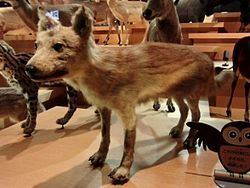
Ranzan's works were studied by German botanist Philipp Franz von Siebold during his tenure in Dejima. He purchased a female mountain dog and a wolf in 1826, describing both in his notes as distinct, and preparing two sketches illustrating their differences. The skin of the mountain dog was subsequently shipped to the Rijksmuseum van Natuurlijke Historie in the Netherlands and mounted. The specimen, along with Siebold's notes, were used by Dutch zoologist Coenraad Jacob Temminck as references for his scientific classification of the animal in Fauna Japonica (1839). Temminck, however, misinterpreted Siebold's notes distinguishing the wolf and the mountain dog and treated the two as synonyms. In 1842, he wrote a longer description, still confounding the two names, and producing a sketch a "wolf" based on Siebold's mounted mountain dog specimen.
Skeletal and genetic findings

The Japanese wolf, or Honshū wolf, (Canis lupus hodophilax Temminck, 1893) is a subspecies of the gray wolf (Canis lupus). Skeletal remains of the Japanese wolf have been found in archaeological sites, such as Torihama shell mound, dating from the Jōmon period (10,000 to 250 B.C).
The Japanese wolf was not the world's smallest wolf. The cranial length of the adult Arab wolf (Canis lupus arabs) measures on average 200.8 mm, which is smaller than most wolves. Specimens of the Japanese wolf were measured between 193.1 mm and 235.9 mm and it was uncertain if these were all from adults. In the mandible, M1 (molar tooth) is relatively larger than in any other canid species. An examination in 1991 found one specimen's condylobasal length (a measure of skull length) to be 205.2mm, and the Alveolar length of P4 (the fourth maxillary premolar or carnassial tooth) to be 20.0mm (left) and 21.0mm (right). In 2009, an osteological study declared that the skull of the Japanese wolf was between 206.4 mm to 226.0 mm in total length, and that morphological characters alone were not sufficient to distinguish the Japanese wolf from large domesticated dogs, such as the Akita breed. Remains of the wild native canine dating from the late Edo period (1603 and 1868), the Yama-Inu, has occasionally been confused with the Japanese wolf because of the osteological similarities between the two.
The Japanese wolf inhabited Kyushu, Shikoku, and Honshu islands but not Hokkaido Island. This indicates that its ancestor may have migrated from the Asian continent through the Korean Peninsula into Japan. The phylogenetic tree generated from its mitochondrial DNA sequences revealed a long branch that separated the Japanese wolf from other gray wolf populations and that it belongs to the ancient mDNA haplogroup 2 (represented today by the Italian wolf and scattered pockets of other wolves across Eurasia), while the Hokkaido wolf belongs to mDNA haplogroup 1 and this suggests that the Japanese wolf was the first arrival on the Japanese archipelago with the Hokkaido wolf arriving more recently from the north. The wolf was estimated to have arrived in Japan during the Late Pleistocene between 25,000–125,000 years ago, however a more recent study that looked at the past sea levels of the Korean Strait together with the timing of the Japanese wolf sequences indicated that it arrived to the southern islands less than 20,000 YBP.
See further: Evolution of the wolf - North America and JapanAn examination of sequences from 113 ancient Canis specimens from China and Russia did not match, which indicated that none of these specimens were the ancestors of the Japanese wolf.
Analyses of the mitochondrial DNA of 1576 dogs worldwide revealed that one Kishu and one Siberian husky possessed the same haplotype as a Japanese wolf, indicating past cross-breeding. A more-refined study of Japanese wolf mitochondrial DNA showed that they could be further divided into two separate groups, and that the sequences from one Kishu, one Siberian husky and one Shiba Inu could also be divided into the two groups. These dogs correspond to clade F of the mDNA phylogenetic tree among worldwide dogs, with clade F haplogroup dogs originating from a rare admixture between male dogs and more than one female ancestor of Japanese wolves, which have contributed to the dog gene pool.
See further Dog-Wolf hybridizationRange
The Japanese wolf inhabited Kyushu, Shikoku, and Honshu islands but not Hokkaido Island. The remains of a 28,000-year-old wolf specimen from the Yana River on the northern coast of arctic Siberia matched the mDNA haplotype of the Japanese wolf, which indicates that they shared common ancestry and a wider distribution.
Physical characteristics
Canis lupus hodophilax was described by Temminck in 1839 as smaller than Canis lupus lupus (Linnaeus 1758) and of shorter legs, with its coat smooth and short. The Japanese wolf was smaller in size compared to the Hokkaido wolf and other gray wolves from the Asian and North American continents. It stood 56–58 cm at the withers.
There are four mounted specimens believed to be Canis lupus hodophilax located at: the National Museum of Nature and Science, Japan; University of Tokyo, Japan; Wakayama University, Japan; Siebold Collection, and the National Museum of Natural History, Leiden, Netherlands.
History
The Japanese wolf is considered to be extinct as the last specimens were recorded at Higashi-Yoshino village in Nara Prefecture, Japan in 1905. Sightings of "short-legged dog like beasts", proposed to be the Japanese wolf, have been claimed since the time of its extinction until the last claim in 1997, but none of these have been verified. A claim in 2000 was dismissed as a hoax. Some Japanese zoologists believe that these reports "merely derive from misidentification of feral dogs".
In 713, the wolf first appeared on record in Kofudoki itsubun (Lost writings on ancient customs). From 967, historical records indicated the wolf's preference for predating on horse, either wild horses or those in pastures, stables, and villages. In 1701, a lord introduced the first wolf bounty and by 1742 the first professional wolf hunters were using firearms and poison. In 1736, rabies appeared among dogs in eastern Japan, indicating that it had entered from China or Korea, then spread across the nation. Shortly after it spread to the wolf population, turning some wolves from simple horse predators to man-killers that lead to organized wolf hunts. Killing wolves became a national policy under the Meiji Restoration, and within one generation the Japanese wolf was extinct.
Some interpretations of the Japanese wolf's extinction stress the change in local perceptions of the animal: rabies-induced aggression and deforestation of the wolf's habitat forced them into conflict with humans, and this led to them being targeted by farmers.
Culture
In the Shinto belief, the ōkami ("wolf") is regarded as a messenger of the kami spirits and also offers protection against crop raiders such as the wild boar and deer. Wild animals were associated with the mountain spirit Yama-no-kami. The mountains of Japan, seen as a dangerous, deadly place, were highly associated with the wolf, which was believed to be their protector and guardian. Many mountain villages, such as Okamiiwa ("Wolf Rock") and Okamitaira ("Wolf Plateau"), are named after the wolf; this could be due to a sighting at the location, or a simple homage to the species.
There are an estimated 20 Shinto wolf shrines on Honshu alone. The most famous national shrine is located at Mitsumine in Chichibu, Saitama Prefecture and there are a number of smaller wolf shrines on the Kii Peninsula, including the Tamaki Shrine and the Katakati Shrine at Totsukawa village.
In Japanese folklore, there is the widely recorded belief of the okuriōkami ("escort wolf") that followed someone walking alone through a forest at night until they reach their home without doing them any harm. An offering was sometimes made for this escort. Another belief was of wolves that raised an infant who had been abandoned in the forests of the Kii Peninsula, and later became the clan leader Fujiwara no Hidehira. Another belief from the Kanto area of eastern Japan was that feeding an infant wolf's milk would make them grow up strong. Some legends portray the Japanese wolf as being prophetic creatures. In the Tamaki Mountains the location of a tree called “the cypress of dog-howls” is said to be the site where wolves howled immediately before a flood in 1889 warning the villagers, and before the great earthquake of 1923 even though the wolf was extinct by that time. Another belief was the "wolf notification" where a traveller does not return home, then a wolf comes to their home and makes a sad howling that signalled their death.
Some villages had wolf charms called shishiyoke that were believed to protect their village and their crops against wild boar. Wolf fangs, hide, and hair were carried by travelers to ward of evil spirits, and wolf skulls were kept in some home shrines to ward off misfortune. In some villages such as in Gifu Prefecture, the skull of the wolf was used as the charm for both protection as well as curing possessed villagers. In addition to protecting the crops, the wolf may leave prey for villagers.
